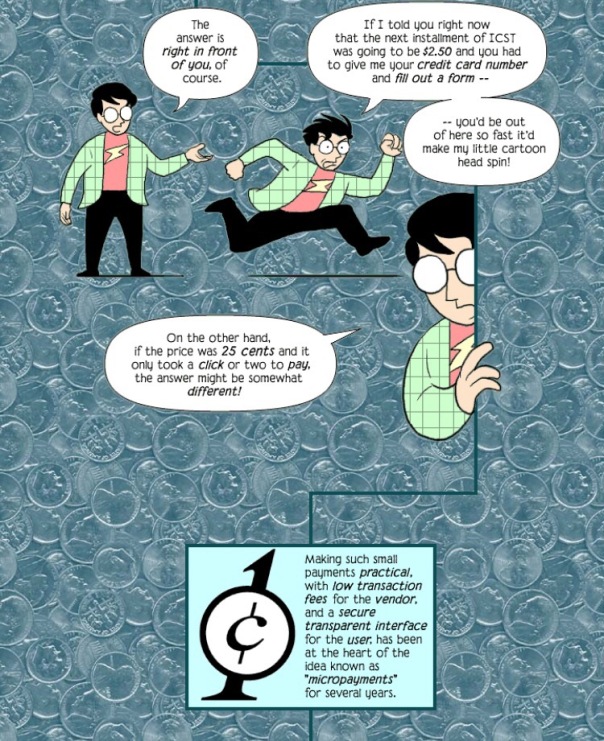The Candy Crush of webcomics: 15 years of gettin’ mad over micropayments

It’s an incident that still spoken in hushed tones around … um … webcomic parts. In 2001, Scott McCloud, he of Understanding Comics, wrote a series of essays about webcomics. It reiterated a series of items that he had introduced in his Reinventing Comics book. Things like the infinite canvas, for example. Basically he was a huge booster of this brave new online world unencumbered by the limitations of print.
So of course he got massive backlash over his segment on micropayments.
If I told you right now that the next installment of ICST was going to be $2.50 and you had to give me your credit card number and fill out a form, you’d be out of here so fast it’d make my little cartoon head spin! On the other hand, if the price was 25 cents and it only took a click or two to pay, the answer might be somewhat different! Making suck small payments practical, with low transaction fees for the vendor, and a secure transparent interface for the user, has been at the heart of the idea known as “micropayments” for several years.
The response was merciless and brutal, with everyone from Jon Rosenberg to Scott Kurtz weighing in. (“You’re only telling us what we already know. You’re no guru; you just get better press than the rest of us,” says Kurtz.) One of the more civil responses came from the Penny Arcade guys… and it’s plenty salty.
I consider myself to be, at my core, an idealist – are you surprised? But this guy’s take on human nature is spun from pure fancy. He imagines that other people – in fact, that everyone – would gladly pay for things if given the chance to do so. That is demonstrably, empirically false – most especially so on the Internet, and most damningly so where content is concerned. But the final strike against his assertions is the most telling: that for all his pirouette, for all his flash and show, the very foundation of his argument – namely, the sub-dollar transactions called micropayments – do not exist. They are not real.
— Jerry Holkins, Penny Arcade, 2001
Perhaps this was right back in 2001, before the iPhone stormed the market. Ultimately though, was Scott McCloud actually right?
Patreon is micropayments made flesh. David Willis’ Dumbing of Age, for example, nets its creator $5,000 a month.
Patreon kept Toothpaste for Dinner going as ad revenue and traffic weakened, while its creator, Drew Fairweather’s attention shifted elsewhere. “The comics themselves are unprofitable but funding through Patreon has allowed me to keep them online and updating daily,” Mr. Fairweather wrote the Observer in an email.
“The monthly Patreon funding constitutes a significant portion of my income,” he explained. “It’s impossible to assign a percent to this, because of the weird nature of Patreon being a merch-subscription service, donation box, and content-paywall at the same time.”
Meanwhile, those new entrants from Korea in the webtoon field are starting to take notice of how micropayments are working for cellphone games.
San Francisco–based Tapas Media, founded in 2012 by Chang Kim, offers bite-size content through an online mobile platform. Its first venture, Tapastic, a webcomics site providing access to more than 16,000 creators and 270,000 individual comics, is the leading online publishing platform and community for comics. Tapastic counts one million active readers, primarily in North America, 90% of whom are under the age of 34.
The company’s newest product is Tapas, a mobile app and marketplace that takes the company’s model of providing content in small amounts and applies it to literary content. The app uses the “freemium” business model—offering some content to consumers for free as an incentive to pay to get more—that has proven successful in the mobile gaming market and brings it to the mobile reading market. Readers are able start books and other stories for free, and then pay to unlock subsequent episodes, or pay for the entire book or story, with prices based on the books’ current market value. Essentially, it’s Candy Crush for books.
Time will tell if this will catch on in the US. I mean… I’ve actually tried some Tapastic recently (the site hosts some comics I’ve looked at recently, such as GaMERCaT and Sarah’s Scribbles, which are both completely free with no “micropayments” attached), and I’ve not felt to sink any money into it yet. But this is a brave new world, where kids are growing up where a fingerprint scan grants them 100 Pokeballs while transactions are hidden behind an animation of cartoon coins that have not direct one-to-one relation with the tiny amounts of money you’re sinking in. The cynic in me says this isn’t going to work… but can one million readers be wrong?
So hey, Scott McCloud… it’s finally payback for that one time Jerry Holkins called you a “self-proclaimed Lord of Comics,” eh?
Posted on November 8, 2016, in webcomics. Bookmark the permalink. 2 Comments.












































































































I remember reading those essays back in the day and actually feeling like it could work. There was a company called “iCents” that was open source and could be used to pay for something across multiple different payment platforms with a click of a button. It seemed really promising at the time (around 2009) but I think it has since gone under.
Coming at this from a sorta different perspective of loving McCloud but not having run into him until a few years ago (when all this was already boiling) this is a real interesting read. I felt a lot of things he talks about were always treated as “This is how it SHOULD be, plan accordingly.”
But that also might be from reading it in 2012/2014/2017 when it was getting there.